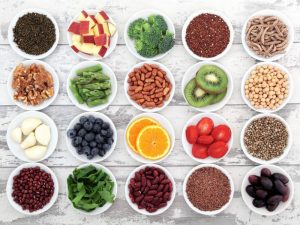We often talk about the importance of including fibre in the diet but not many people know what fibre is, how to include it in the diet and what the health benefits are.
What is dietary fibre?

https://streamingfit.com/wp-content/uploads/2016/06/top-10-high-fibre-foods.jpg
Dietary fibre is a plant-based nutrient. It cannot be properly and completely digested in the gut and passes through relatively unchanged.
Are there different types of fibre?
There are two main types of fibre, namely soluble – and insoluble fibre.
Soluble fibre dissolves in water and turns into a gel-like substance, while insoluble fibre does not dissolve in water at all and is commonly known as “roughage”. Both soluble and insoluble fibres have important benefits. Soluble fibre has been shown to improve blood sugar levels and helps lowering blood cholesterol levels. Insoluble fibre speeds up the passage of food through the digestive system, maintains regular passing of stools and prevents constipation. It also increases faecal bulk. Good sources of soluble fibre include fruits, vegetables, lentils, peas, beans, oats, barley, oatmeal, and dried fruit. Good sources of insoluble fibre include foods with whole wheat flours and breads, wheat bran, brown rice, whole grain cereals, edible peels of fruit, nuts and seeds.
What are the benefits of including fibre in the diet?
- Digestion
Fibre improves digestion by increasing stool bulk and regularity. Stools that are soft and bulky are easier to pass, which helps maintain gut health. A diet high in fibre might also assist in reducing the risk of haemorrhoids and diverticulitis.
- Weight loss
Dietary fibre has been associated with improved body weight and weight loss. Consuming a diet high in fibre is known to result in a feeling of satiety, making an individual feel fuller for longer and more likely to eat less. High fibre foods also tend to be lower in kilojoules.
- Heart health
Fibre known to improve heart health by lowering blood cholesterol levels. The digestive process requires bile acids, which are made partly with cholesterol. As your digestion improves, cholesterol is removed from the blood to create more bile acid, thereby reducing the amount of LDL cholesterol in the blood, also known as “bad” cholesterol.
- Blood sugar regulation
A high fibre intake, particularly soluble fibre, can regulate blood glucose levels and reduce levels of HbA1c (glycated haemoglobin). HbA1c is associated with an increased risk of developing complications associated with diabetes.
- Possible cancer prevention
There is an association between the intake of cereal fibre and whole grains and a reduced risk of developing colorectal cancer. Fibre naturally reacts with bacteria in the lower colon which ferment into chemicals associated with the destruction of cancer cells. A high fibre diet can help encourage the bacteria’s growth.
Tips on how to introduce fibre into your diet:
- Start the day with a high fibre cereal (such as oats, oat bran, All Bran, Hi Fibre Bran, whole wheat Pronutro) or whole wheat bread.
- Eat lots of fruit and vegetables every day:
- Eat fresh fruit and raw vegetables / salad.
- Use raisins (or dried fruit) instead of sugar in cereal.
- Use plenty of vegetables in stews and soups.
- Switch to brown or wild rice, brown, whole wheat bread & whole wheat pasta.
- Add seeds and nuts to salads (Tip: toast seeds and nuts in a dry pan before adding them to food to enhance the flavour).
- Add ground flaxseeds to smoothies or cereal.
- Eat more legumes (beans, peas, lentils) – use in a salad or bulk up stews and soups.
- Drink up to 2 litres of water per day (6-8 glasses). Fibre will not have the desired effect if you do not drink enough water.
Note: Fibre should be introduced into the diet gradually to avoid gut discomfort and bloating.


Recent Comments